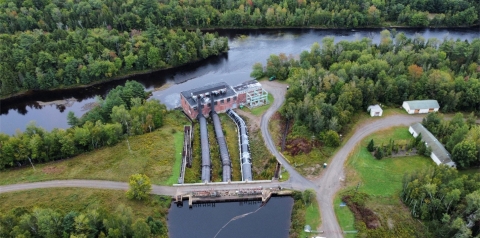States
MaineThis project will help restore hundreds of miles of currently restricted habitats for river herring and other sea-run species on the international Skutik/St. Croix River watershed at the Milltown, Woodland, and Grand Falls dams. The current funded project will contribute to the construction of fishways at lower river dams at Woodland and Grand Falls, synergizing the removal of downstream Milltown Dam. This project has the potential to support tens of millions of adult river herring returns annually, resulting in the largest runs of river herring in the U.S. and Canada, while also contributing to improving the sustainability and economic viability of the local pulp, paper, and fishing industries.
Project Quick Facts:
- Location: Maine
- Federal Investments to Date: $57,000,000
- Non-Federal Investments to Date: $1,000,000
- Type of Barriers: Dams with outdated fishways
- Number of Barriers: 2
- Stream Miles Reopened: 600
- Acres Restored: 68,000
- Project Leads: Maine Department of Marine Resources, Passamaquoddy Tribes
- Non-Federal Partners Include: The Nature Conservancy, Woodland Pulp LLC, Peskotomuhkati Nation at Skutik
- Federal Agencies Invested to Date: U.S. Fish and Wildlife Service, National Marine Fisheries Service
Removing Barriers to Success
The first dam on the river, Milltown Dam, was removed in 2023 and funding was secured for fishway construction at Woodland Dam. Additional funding is needed to complete the Grand Falls fish passage fish passage
Fish passage is the ability of fish or other aquatic species to move freely throughout their life to find food, reproduce, and complete their natural migration cycles. Millions of barriers to fish passage across the country are fragmenting habitat and leading to species declines. The U.S. Fish and Wildlife Service's National Fish Passage Program is working to reconnect watersheds to benefit both wildlife and people.
Learn more about fish passage project. These projects will promote and enable future conservation actions in the watershed, including connectivity projects on upstream tributaries.
The Importance of Transformational Fish Passage Projects
This project is one of over 70 grand-scale, community-centric restoration projects, identified by the Federal Interagency Fish Passage Task Force, that not only rejuvenate ecosystems but also bolster the climate resilience and economies of communities across the country. Learn more about these ground breaking projects in our Reviving Rivers, Reconnecting Communities story map.
The National Fish Passage Program combines technical expertise with a track record of success.
Implemented primarily through the Service's Fish and Wildlife Conservation Offices, the National Fish Passage Program provides financial and technical assistance to partners across the country. Since 1999, the program has worked with over 2,000 local communities, Tribes, and private landowners to remove or bypass over 3,400 barriers to fish passage and reopen access to over 61,000 miles of upstream habitat for fish and other animals. Staff have expertise in fish migration and biology as well as financial, engineering, and planning assistance to communities, Tribes, and landowners to help them remove barriers and restore rivers for the benefit both fish and people.
Fish passage project proposals can be initiated by any individual, organization, government, or agency. However, proposals must be submitted and completed in cooperation with a Fish and Wildlife Conservation Office. (Please note that fish passage projects being used for federal or state compensatory mitigation or required by existing federal or state regulatory programs are not eligible for funding through the National Fish Passage Program.)
CONTACT A FISH PASSAGE COORDINATOR IN YOUR AREA TO GET STARTED.



